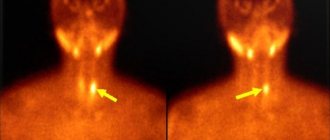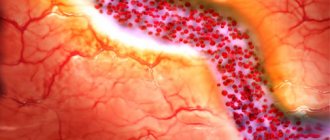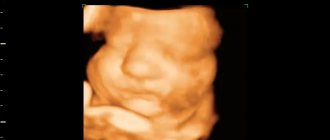Anisocytosis is a pathological change in the size of red blood cells and platelets that occurs against the background of various human diseases. Anisocytosis of mixed type is more often diagnosed in medical practice. Blood is the internal medium of the body and performs an important function, providing all organs and systems with oxygen and nutrients. Changes in the shape and size of the cells of this substance often indicate the development of serious diseases, but additional medical research is required to clarify the diagnosis.
Characteristics of anisocytosis, their types
Red blood cells can have different diameters.
| Name | Diameter (µm) |
| Normocytes | 7 – 8 |
| Macrocytes | 8 – 12 |
| Megacytes | > 12 |
| Microcytes | < 7 |
A healthy person has red blood cells of all sizes. But a violation of their ratio is a pathology.
The proportion of normocytes should be 70% of the total volume. The volume of microcytes and macrocytes takes up no more than 15% separately.
Photo: https://pixabay.com/illustrations/heart-red-blood-cells-erythrocyte-2176218/
Classification of anisocytosis
Erythrocyte anisocytosis is divided into several categories.
Based on the size of the predominant cells, they are distinguished:
- Macrocytosis – increased number of macrocytes. When red blood cells are too large, there are fewer of them than needed and they carry less hemoglobin. This means that the blood is not sufficiently rich in oxygen. Low blood oxygen saturation causes a variety of symptoms and health problems.
- Microcytosis – the number of microcytes significantly exceeds the norm. Small red blood cells have a weak ability to carry oxygen, since they have a low concentration of hemoglobin.
- Mixed variant – increased number of macrocytes and microcytes.
Depending on the severity, the following types of anisocytosis are distinguished:
| Name | Designation in analyzes | Proportion of red blood cells with abnormal size (%) |
| Minor | + | 25 |
| Moderate | ++ | ≈ 50 |
| Expressed | +++ | ≈ 70 – 75 |
| Pronounced | ++++ | ≈ 100 |
Red blood cells are normal
The normal limits vary depending on gender, age and other characteristics.
So, for an adult man it ranges from 4.0 to 5.1 × 10¹² units per liter of blood, and for women - 3.7 to 4.7 × 10¹² per liter.
In pregnant women, red blood cells may decrease to 3–3.5 x 10¹² per liter.
In children under one year of age, the concentration of red blood cells is constantly changing, so to assess the composition of their blood there is a special table that doctors use when interpreting tests.
In childhood, after one year there are still slight deviations from the “adult” norm, but by adolescence the level of red blood cells levels out.
Reasons for the development of anisocytosis
Etiology of macrocytosis
Vitamin B12 deficiency
Vitamin B12 deficiency is the cause of macrocytosis. A lack of vitamin B12 in the diet is rare and usually occurs only in older people on the “tea-and-toast diet” or in strict vegetarians.
However, deficiency can be caused by the following.
- Lack of intrinsic factor (an enzyme that ensures the absorption of B12) in patients who have undergone gastrectomy (removal of the stomach) or have pernicious anemia.
- Vitamin B12 malabsorption resulting from bacterial infection in the small intestine, tapeworm infestation, certain medications, ileal bypass, enteritis, intestinal malabsorption.
Folate deficiency
Folic acid deficiency can also lead to macrocytosis. Its disadvantage arises due to:
- dietary deficiency;
- increased need during pregnancy;
- congenital deficiency;
- malabsorption in the intestine;
- alcoholism.
Photo: https://www.pexels.com/
Drug-induced macrocytosis
Drug-induced macrocytosis is the most common cause in non-alcoholic patients.
The following categories of drugs are known to cause macrocytosis:
- antagonists (having the opposite effect) of folic acid (Methotrexate);
- purine antagonists (6-Mercaptopurine);
- pyrimidine antagonists (Cytosine arabinoside);
- alkylating agents (Cyclophosphamide);
- inhibitors (inhibiting the action) of tyrosine kinases (Sunitinib and Imatinib);
- Zidovudine;
- Trimethoprim;
- oral contraceptive pills;
- Phenytoin.
The tyrosine kinase inhibitors Sunitinib and Imatinib have been shown to induce macrocytosis in patients with various types of cancer, including renal cell carcinoma (RCC), gastrointestinal tumors, and breast cancer. In patients with RCC, the development of macrocytosis after treatment with Sunitinib may potentially serve as a positive prognostic factor for overall survival.
Persistent anemia of the following types can cause macrocytosis:
- myelodysplastic anemia;
- aplastic anemia;
- acquired sideroblastic anemia.
Photo: https://www.pexels.com/photo/colors-colours-health-medicine-143654/
Etiology of microcytosis
Microcytosis can occur with several different conditions, ranging from mild problems to more serious ones.
Thalassemia
This is a hereditary blood disorder that parents can pass on to their children due to gene mutations.
With this pathology, the body does not produce enough of a certain protein, usually contained in hemoglobin.
Without it, red blood cell formation does not occur properly.
Chronic conditions
Some chronic diseases can cause microcytosis:
- kidney disease;
- certain types of cancer (Hodgkin's disease, non-Hodgkin's lymphoma, and breast cancer);
- diabetes;
- heart failure;
- Crohn's disease;
- inflammatory bowel diseases;
- rheumatoid arthritis;
- lupus;
- infectious diseases (HIV, AIDS, tuberculosis).
Iron-deficiency anemia
The most common cause of microcytosis is a lack of iron in the blood. Iron deficiency anemia occurs due to:
- insufficient iron intake;
- inability to absorb iron due to certain pathologies (celiac disease or Helicobacter pylori infection);
- chronic blood loss due to frequent or heavy menstrual flow in women or gastrointestinal bleeding;
- pregnancy.
Lead poisoning
Children who are exposed to lead-based paint because they live in an old home or because of toys or other items can suffer lead poisoning.
Polluted water and heavy industrial pollution can also cause lead poisoning, although this is less common.
Sideroblastic anemia
Congenital sideroblastic anemia is an inherited blood disease that affects the ability of the bone marrow to produce red blood cells. It also causes microcytosis, but is less common than other causes.
Symptoms of pathology
Anisocytosis is not an independent disease; the condition is characterized by a disturbance in the composition of the blood under the influence of one or another pathology (for example, anemia, oncology, liver disease). Symptoms of this condition can be very diverse, depending on in which organ the pathological changes occur.
Common signs of anisocytosis include asthenia. The concept implies the development of weakness, fatigue, and irritability in a person. When performing light physical work, the patient notices shortness of breath and loss of strength. Psychological disorders occur. Sleep is often disturbed, mood changes occur, a person becomes aggressive or, conversely, apathy and reluctance to communicate with other people develop.
Many patients are diagnosed with heart rhythm disturbances. As a result, paleness or redness of the skin, dizziness, and flickering of spots before the eyes may occur.
In general, anisocytosis is characterized by signs of heart failure, but when examining the heart, no abnormalities in the functioning of the organ are noted, because the symptoms arise due to a violation of the percentage of blood cells, which can cause difficulties in diagnosis.
Symptoms indicating changes in red blood cells
There are various symptoms of anisocytosis. Some of them are mild, but they can gradually become severe.
A person with anisocytosis often experiences the following symptoms.
- Rapid breathing. This is a common symptom. Its occurrence is associated with a deficiency of hemoglobin, which leads to insufficient oxygen transport. Thus, patients often feel short of breath after minimal activity.
- Paleness . Since the necessary oxygen does not reach our skin, nails and eyes as it should, they become paler.
- Lethargy. With abnormal red blood cell sizes, oxygen distribution is inadequate. Consequently, general fatigue and lethargy are also common symptoms.
- Tachycardia. Palpitations occur not only after physical activity, but also in normal everyday life. The heart pumps quickly to compensate for the body's need for oxygen, and therefore the number of heartbeats increases.
Some other symptoms may also be present:
- headache;
- low body temperature;
- cold palms and feet;
- dizziness (feeling of falling).
Photo: https://pixabay.com/photos/sad-woman-upset-female-people-2385795/
Elevated red blood cells
Red blood cells can be elevated due to many reasons, ranging from banal dehydration to erythremia - chronic leukemia.
Therefore, if there are any deviations in test results, you should consult a specialist to determine the cause. An increase in the number of red blood cells is called erythrocytosis, which can be: 1. Primary. A rare hereditary disease characterized by loss of energy, dizziness and darker color of the mucous membranes. 2. Secondary. Caused by other diseases or conditions (for example, smoking or staying in high mountains) and is associated with oxygen starvation of cells.
Thus, the following reasons for the increase in red blood cells can be identified:
- Dehydration. When the volume of fluid in the body is reduced, the percentage of red blood cells (and other blood cells) artificially increases.
- A lack of oxygen, which the body tries to compensate by producing more red blood cells.
- Congenital heart defect. If the heart cannot pump blood effectively, the amount of oxygen reaching the tissues is reduced. The body creates more red blood cells to compensate for oxygen deprivation.
- Genetic causes (changes in sensitivity to oxygen, impaired release of oxygen by hemoglobin).
- Polycythemia vera is a rare disease in which the body produces too many red blood cells.
Increased production of red blood cells can cause blood to thicken, slow blood flow, and related problems (eg, headaches, dizziness, vision problems, excessive blood clotting).
Often, elevated red blood cell levels are due to dehydration, hot weather, extreme stress, or excessive exercise. A pathological increase in red blood cells is a fairly rare pathology. Much more often, patients encounter reduced levels.
Laboratory diagnostics. Criteria
The main way to diagnose anisocytosis is a blood test.
Red blood cell distribution width (RDW)
This parameter is used to measure the size and volume of red blood cells. RDW increases in accordance with changes in red blood cell size.
The normal RDW parameters are as follows:
| Adults | 13 % |
| Children under 6 months. | 16,8 % |
| Children from 6 months. | 13,2 % |
If results exceed the normal range, this indicates the presence of anisocytosis.
Doctors often compare the RDW result to the mean cell volume (MCV).
Results may show:
| results | Causes |
| Normal RDW and MCV | Anemia may be caused by a chronic illness or blood loss. |
| Normal RDW and low MCV | Anemia caused by a chronic condition or thalassemia. |
| Normal RDW and high MCV | Liver pathology or alcohol abuse. Use of antiviral and chemotherapeutic drugs. |
| High RDW and normal MCV | Deficiency of iron, B12 or folic acid. Possible chronic liver disease. |
| High RDW and low MCV | Iron deficiency, microcytosis. |
| High RDW and high MCV | Lack of B12 or folic acid, macrocytosis. Possible chronic liver disease. |
Photo: https://pixabay.com/photos/medic-hospital-laboratory-medical-563423/
Color index
Another indicator used in the diagnosis of various types of anisocytosis. They indicate the amount of hemoglobin in a red blood cell.
The normal value is in the range of 0.85 - 1.05.
Hypochromia in a general blood test, when the color index is less than 0.85, may indicate the presence of microcytosis. Hyperchromia (indicator more than 1.0) possibly indicates macrocytosis.
Preventive actions
Anisocytosis is not an independent pathology, but only signals the development of other diseases of the body, so due attention should be paid to the prevention of this condition. To avoid changes in blood composition, you should adhere to the following preventive measures:
- Correctly adjust your diet, saturate your diet with food containing a sufficient amount of iron;
- take blood tests regularly;
- promptly treat infectious diseases;
- to refuse from bad habits;
- pay due attention to sports. Physical activity has a beneficial effect on the body’s metabolic processes, which has a positive effect on blood composition;
- If you notice such signs as weakness, fatigue, apathy, you must inform your doctor about this.
By following a healthy lifestyle, you can prevent serious illnesses. Proper nutrition, hardening and exercise can strengthen the immune system and prevent the development of severe pathologies.
Treatment of anisocytosis
Treatment will depend on the cause of the anisocytosis.
It is important to determine the cause of the problem so that proper treatment can begin.
Anisocytosis is often associated with anemia, and anemia is usually caused by iron or vitamin deficiency.
The usual treatment for iron deficiency is taking iron supplements and changing your diet to increase your iron levels with iron-rich foods.
Iron-rich foods:
- dark green leafy vegetables;
- brown rice;
- beans;
- nuts and seeds;
- meat and fish;
- tofu;
- eggs;
- dried fruits.
Patients can also address vitamin deficiencies by taking supplements and making changes to their diet.
In severe cases of anisocytosis, your doctor may recommend a blood transfusion. This process will replace blood containing abnormal cells with blood containing healthy cells.
Photo: https://pixabay.com/photos/asparagus-steak-veal-steak-veal-2169305/
Indications for analysis
There are several reasons to perform the RDW diagnostic test. Often this procedure is performed before surgery or if anemia is suspected. In some clinics, RDW is included in the list of routine tests that the patient must undergo regularly.
Together with the MCV analysis, the RDW study is prescribed for:
- differential diagnosis of iron deficiency anemia and thalassemia.
- differential diagnosis of B-12 and folate deficiency anemia and other megaloblastic anemias.
Often, the initial appointment comes with complaints, which become the main indications for examination for RDW:
- constant dizziness;
- poor sleep;
- darkening of the eyes;
- general weakness;
- nausea;
- tinnitus;
- the formation of bruises of unknown origin on the body;
- enlarged lymph nodes.
Note: Hip fracture patients who experience large fluctuations in RDW during treatment are at increased risk of mortality within two years.
Anisocytosis and poikilocytosis
Anisocytosis and poikilocytosis refer to abnormalities in red blood cells. The key difference between the two is that in anisocytosis the cells are abnormal in size, while in poikilocytosis the red blood cells are abnormally shaped, meaning they do not have the standard biconcave shape.
Types of cell deformation.
| Name | Characteristic | Causes |
| Spherocytes | No flattened, lighter center | Hereditary spherocytosis, autoimmune hemolytic anemia, hemolytic transfusion reactions, erythrocyte fragmentation disorders. |
| Dental cells | The central part is elliptical or slot-shaped instead of round | Alcoholism, liver disease, hereditary stomatocytosis. |
| Codocytes | The cell looks like a target with a red dot in the center | Thalassemia, cholestatic liver disease, absence of spleen (splenectomy). Rarely, sickle cell anemia, iron deficiency anemia, and lead poisoning are possible. |
| Leptocytes | Thin flat cells with hemoglobin on the edge | Thalassemia and obstructive liver diseases. |
| Drepanocytes | Crescent elongated shape | Sickle cell anemia, thalassemia. |
| Elliptocytes | Slightly oval or cigar-shaped with blunt ends | Hereditary elliptocytosis, thalassemia, myelofibrosis, liver cirrhosis, iron deficiency or megaloblastic anemia. |
| Dacryocytes | Cells have one round and one pointed end | Thalassemia, myelofibrosis, leukemia, megaloblastic or hemolytic anemia. |
| Acanthocytes | Cells with abnormal spiny projections at the edge of the cell membrane | Abetalipoproteinemia, severe alcoholic liver disease, absent spleen, autoimmune hemolytic anemia, kidney disease, thalassemia, McLeod syndrome. |
| Echinocytes | Spiny projections distributed throughout the cell | Kidney disease, cancer, long-stored blood transfusion, pyruvate kinase deficiency. |
| Schizocytes | Red blood cell fragment | Sepsis, severe infection, burns, tissue damage. |
Photo: https://ppt-online.org/46925
Microcytosis
Click to enlarge
Microcytosis is a condition when the majority (about 30%) of red blood cells change into a minority. Their number has increased, but the standard size differs several times.
Microscopic red blood cells do not transport full-fledged oxygen throughout tissues and organs in the same way as healthy and full-fledged normocytes produce.
With a normal, average diameter of a red blood cell in adults, 6.8 and 7.5 microns are found.
With a regular biconvex disc, the red blood cells are of normal diameter, volume, colors and shapes, this is called a normocyte. In private clinics, the norm is indicated, ranging from 6 to 8.5 microns. A child or teenager, taking into account age, is subject to a norm of 7 to 8.1 microns.
If microcytosis is detected in the analysis, iron deficiency anemia can be further diagnosed.
Symptoms of deviation
Anisocytosis is a condition that in most cases is a sign of anemia. The symptoms are similar. Severe signs of this condition resemble manifestations of heart failure. If you notice the signs described below, consult a doctor and take a general blood test:
- fast fatiguability;
- decreased performance;
- loss of concentration;
- lack of ability to play sports;
- impotence and loss of strength;
- shortness of breath during exertion or for no apparent reason, appearing periodically;
- rapid heartbeat without any exertion;
- increased pumping of the heart muscle;
- pale skin;
- pale color of nail plates;
- pallor of the eyeballs;
- headache;
- noise in ears;
- disturbances of normal appetite and sleep;
- the level of sexual desire decreases;
- impaired skin sensitivity.
If these symptoms appear, you should consult a doctor.
RDW standards
The analysis results are calculated using a special analyzer. In most cases, the procedure is performed in combination with the MCV index. This combination helps to determine one or another type of microcytic anemia.
Reference (corresponding to normal) indicators of RDW in human blood range from 11.5% to 14.5%. The optimal coefficient value is 13%. These figures are the same for both adults and children over six months old, i.e. do not change throughout life.
Reference values, %:
- up to 6 months — 14.9-18.7
- over 6 months — 11.6-14.8
If all indicators are normal, the test result is negative.
If the RDW is elevated, the result is considered positive. Important! The interpretation of the results is always carried out comprehensively. It is impossible to make an accurate diagnosis based on only one analysis.










